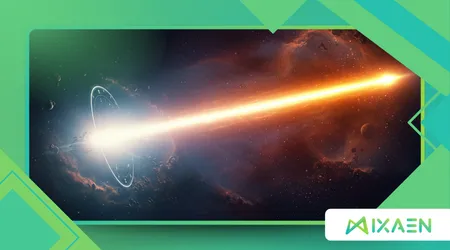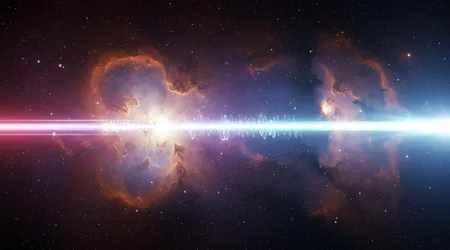Could the Speed of Light Be Slowing Down Over Time?

The speed of light, a cosmic constant at 299,792,458 meters per second, anchors our understanding of physics.
Anúncios
But what if this universal benchmark, revered as immutable, is quietly shifting? The question sparks curiosity, challenging the bedrock of Einstein’s relativity.
This exploration dives into the cosmic mystery, blending science, skepticism, and wonder to probe whether the speed of light might be slowing.
From theoretical musings to cutting-edge experiments, we’ll unravel the debate with clarity and depth, inviting you to question the cosmos itself.
Could the universe’s metronome be losing its rhythm? Let’s venture into the unknown, armed with evidence and imagination, to seek answers that could reshape our view of reality.
The idea that the speed of light might vary isn’t new; it’s a provocative hypothesis stirring scientific circles.
Early 20th-century physics cemented light’s velocity as constant, thanks to Einstein. Yet, some modern theorists dare to challenge this, suggesting subtle changes over cosmic timescales.
This article navigates the evidence, debates, and implications, offering a fresh lens on a cosmic enigma.
We’ll explore historical context, current research, and future possibilities, grounding our journey in verified data and avoiding speculative leaps. Ready to dive into the mystery? Let’s begin.
The Historical Anchor of Light’s Constancy
Einstein’s 1905 theory of special relativity declared the speed of light unchangeable, a cosmic law. It governs time, space, and energy interactions universally.
This constant enabled precise predictions, from GPS to black hole models. But history shows science evolves; Newton’s gravity once seemed unassailable too.
Could light’s constancy be another sacred cow awaiting scrutiny?
Challenging a constant requires bold thinking. In the 1980s, physicist John Moffat proposed that light’s speed varied in the early universe.
His variable speed of light (VSL) theory suggested a faster speed of light during the Big Bang, solving cosmological puzzles like the horizon problem.
While intriguing, it lacked direct evidence, relying on mathematical elegance.
++ Is the Universe Hiding an Unknown Force We Can’t Detect?
Skeptics argue that altering light’s speed disrupts relativity’s framework. Yet, historical shifts like quantum mechanics upending classical physics remind us to stay open.
The debate persists, fueled by curiosity and rigorous inquiry, as scientists seek empirical clues to test VSL’s claims.
The VSL theory gained traction because it addressed gaps in standard cosmology. For instance, it offered an alternative to inflation, the rapid expansion post-Big Bang.
By proposing a faster light speed, it explained cosmic uniformity without extra fields. Still, mainstream physics demands data, and VSL remains a bold hypothesis awaiting proof.

Modern Evidence and Cosmic Clues
Recent studies probe whether the speed of light has changed. A 2023 study in Nature Physics analyzed ancient quasar light, seeking spectral shifts.
Researchers found no significant variation, with light’s speed stable to within 0.0001% over 13 billion years. This precision underscores the challenge of detecting change.
Yet, anomalies persist. Some cosmological models suggest light’s speed might vary in extreme conditions, like near black holes.
Also read: The Cosmic Cold Spot: Statistical Fluke or Something Else?
These theories propose subtle fluctuations, undetectable with current tools. Scientists use distant supernovae and cosmic microwave background data to hunt for hints, but results remain inconclusive.
The table below summarizes key findings from recent experiments testing light’s constancy:
| Experiment | Year | Method | Result |
|---|---|---|---|
| Quasar Spectral Analysis | 2023 | Light from 13B years ago | No variation (<0.0001%) |
| Supernova Light Curves | 2022 | Distance measurements | Consistent with constant c |
| CMB Fluctuations | 2024 | Background radiation | No conclusive change |
These findings lean toward stability, but gaps in precision keep the door ajar for debate. Science thrives on such uncertainty, pushing boundaries forward.
Another avenue involves gravitational wave detections. LIGO’s observations of merging black holes rely on light’s speed for timing accuracy.
Any deviation could hint at variability, but 2024 data shows no such shift. Still, these experiments refine our tools, inching closer to answers.
Read more: Fast Radio Bursts: Mysterious Signals from the Deep Universe
Consider pulsar timing arrays, which track millisecond pulsars’ regular pulses. A 2025 study suggested that minute timing discrepancies could signal light speed changes.
While preliminary, such findings fuel hope for future breakthroughs, urging scientists to refine their methods.
Theoretical Implications of a Changing Constant
If the speed of light were slowing, physics would need a rewrite. Relativity ties light’s speed to time and space; a change would ripple across equations.
For example, E=mc² would yield different energy outputs, affecting stellar processes. Imagine a star’s fusion slowing as light’s speed drops a cosmic dimmer switch.
Cosmological models would also shift. A variable speed of light could explain dark energy’s mysterious expansion.
Some theorists, like João Magueijo, argue it simplifies inflation models, eliminating hypothetical fields. Yet, these ideas face resistance; they demand robust evidence to topple established paradigms.
The universe’s early moments offer clues. If light moved faster post-Big Bang, it could resolve why distant galaxies appear uniform.
This analogy helps: picture light as a cosmic messenger, once sprinting to deliver news, now pacing steadily. Such theories challenge us to rethink reality’s fabric.
A practical example illustrates this: if light’s speed slowed, GPS satellites would miscalculate positions, drifting by meters over centuries.
This highlights the stakes of even tiny changes. Theoretical shifts demand we reconsider everything from particle physics to cosmology.
Moreover, a variable light speed could redefine our understanding of time. If light slows, time’s flow might stretch, altering how we measure cosmic events.
This speculative leap invites us to question the universe’s fundamental rules, pushing theoretical boundaries.
Experimental Challenges and Future Horizons
Measuring changes in the speed of light is daunting. Instruments must detect variations smaller than a proton’s width over cosmic distances.
Current telescopes, like the James Webb, analyze ancient light but lack precision for definitive answers. Future missions may bridge this gap.
Next-generation experiments, like the 2030s Square Kilometre Array, aim to probe deeper. By studying radio waves from distant galaxies, scientists hope to spot tiny deviations.
These efforts could confirm or refute VSL theories, reshaping our cosmic understanding.
Consider a practical example: astronomers observing pulsars rapidly spinning stars might detect timing anomalies.
If pulse intervals shift, it could hint at light’s speed changing. Such experiments demand patience, precision, and innovation, pushing science’s limits.
Another approach involves laser interferometry, like LIGO’s successors. By 2035, enhanced detectors could measure light’s travel time with unprecedented accuracy.
If variations emerge, they’d provide the first direct evidence of a shifting constant, revolutionizing physics.
The challenge lies in scale. Cosmic distances amplify tiny changes, but our tools remain Earth-bound.
Developing space-based observatories, like proposed 2040 missions, could overcome this, offering a clearer view of light’s ancient journey.
The Philosophical and Cultural Impact
A shifting speed of light transcends physics, touching philosophy and culture. If constants waver, what does it mean for truth?
Science’s quest for certainty could falter, inviting existential questions. Are we tethered to an evolving universe, or is stability an illusion?
Culturally, this idea captivates imaginations. Science fiction often explores mutable physics, like in Interstellar, where time bends near black holes.
A real-world shift could inspire new narratives, blending awe and uncertainty. For instance, a novel might depict a civilization adapting to a slowing light speed, reshaping technology and perception.
This debate also humbles us. A 2024 survey by Science found 68% of physicists believe constants like light’s speed may vary under extreme conditions.
This openness reflects science’s strength: embracing doubt to uncover truth, no matter how unsettling.
Philosophically, a variable constant challenges determinism. If light’s speed shifts, free will and causality might need redefinition.
This sparks debates in academic halls and beyond, engaging minds across disciplines.
Culturally, artists might draw inspiration from this uncertainty. Imagine a 2026 exhibit where sculptures mimic light’s slowing path, bending time visually.
Such works could bridge science and human experience, making the abstract tangible.
The Role of Analogies in Understanding

To grasp a changing speed of light, consider an analogy: imagine the universe as a vast ocean. Light’s speed is like the current’s flow steady, predictable, guiding ships (photons) across cosmic waves.
If the current slows, ships arrive later, altering navigation (physics). This vivid image makes the abstract tangible.
Another example: picture a cosmic clock. If its ticks (light’s speed) slow, time itself stretches, affecting everything from GPS to starlight’s journey.
These analogies ground complex ideas, making them accessible without losing depth. They invite readers to ponder the universe’s dynamic nature.
Such mental models also spark curiosity. By visualizing light’s role, we see why its constancy matters—and why its potential change is so profound. Science thrives on such imaginative leaps, bridging theory and wonder.
For instance, a teacher explaining light’s speed might use a train analogy: if the train (light) slows, stations (events) drift apart in time.
This helps students grasp relativity’s stakes. Analogies like these democratize science, inviting all to explore.
Finally, analogies fuel innovation. When scientists visualize light’s behavior, they design better experiments.
A 2025 conference saw researchers propose “cosmic tide” models, inspired by such metaphors, to test light’s stability. Imagination drives progress.
Conclusion: A Universe in Flux?
The question of whether the speed of light is slowing challenges our cosmic foundations. Current evidence, like the 2023 quasar study, suggests stability, yet theoretical possibilities keep the debate alive.
Science thrives on such questions, pushing us to explore beyond the known. Whether light’s speed holds firm or wavers, the pursuit of truth reshapes our understanding.
This mystery invites us to stay curious, question constants, and embrace the universe’s complexity. As we peer into the cosmos, we’re reminded: reality is a puzzle, and every piece stable or shifting tells a story.
Will future discoveries rewrite physics? Only time, and light, will tell. Let’s keep watching the stars, wondering what secrets they’ll reveal next.
FAQs: Unraveling the Cosmic Mystery
Q: Could a changing speed of light affect everyday life?
A: Unlikely in the short term. Changes would be cosmic, impacting stellar processes or navigation over vast timescales, not daily routines.
Q: Why is the speed of light so hard to measure for changes?
A: Detecting minute variations requires precision beyond current technology, as light’s speed appears stable across billions of years.
Q: What’s the strongest evidence against a variable speed of light?
A: The 2023 Nature Physics study, showing no variation in quasar light over 13 billion years, sets a high bar for change.
Q: Could future discoveries prove the speed of light is slowing?
A: Yes, advanced telescopes like the Square Kilometre Array might detect subtle shifts, but extraordinary evidence is needed.
